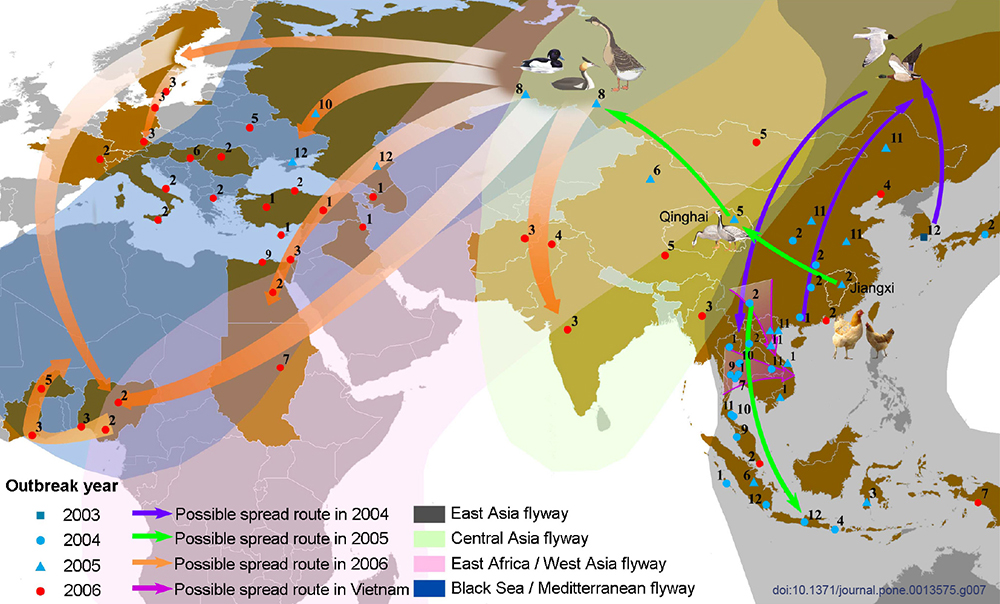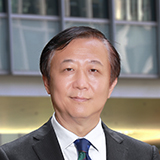November 2021 | Volume 23 No. 1
Cover Story
Chain Reactions
The H5N1 bird flu first jumped to humans in 1997 in Hong Kong, killing six of the 18 patients infected. But that was not the end of H5N1. In 2003 it resurfaced in humans and over the next few years was detected in wild birds in many regions around the world. For Professor Peng Gong, who has devoted much of his career to spatial modelling and identifying connections between the environment and disease, this proved to be a telling example of a One Health challenge.
While others focussed on the disease, he applied his expertise to understand the bigger picture by mapping the environmental factors behind the spread of H5N1 globally.
“We found that because of land use changes and climate change, the protected habitats of wild birds were shrinking and so you had more birds using a smaller area. This helped facilitate the virus to pass between them and strengthened transmission of the disease. And because of the reduced habitat, it also brought them closer to poultry and duck farms that are run by humans, and infected these vulnerable birds,” he said.
“Humans have been squeezing the living space for other species that have nowhere to escape to. With One Health, we need to take a systematic view – in Chinese, One Health is called ‘Big Health’ – because the health of the ecosystem is actually related to human health.”
Professor Gong, who is concurrently Chair Professor in the Faculty of Social Sciences (Geography) and Faculty of Science (Earth Sciences) and HKU’s Vice-President and Pro-Vice-Chancellor (Academic Development), has been working on One Health issues for more than two decades. His expertise has been recognised by the prestigious health journal The Lancet, which recently appointed him as the only non-medical member of its international advisory board (previously he was an advisor on two specialty publications of The Lancet focussing on public health and planetary health).

Representative spread routes of the H5N1 viruses in four years. Triangles and dots represent spatial-temporal cluster centres. The numbers on the triangles and dots are the reported months of the cases.
Interdisciplinary collaboration
His interest in using a systems-based approach to analyse the interactions of the environment and health began in the 1990s with a mathematical model on the spatial distribution of schistosomiasis, a disease caused by parasitic worms that breed in both snails and humans and that can infect people through contact with contaminated freshwater. It can cause multiple health problems, particularly after prolonged exposure, and as a parasitic disease is second only to malaria in the devastation it causes around the world.
China is one of the countries affected by schistosomiasis, so Professor Gong first applied his mapping skills there, in collaboration with public health specialists from UC Berkeley, to show which areas were suitable for the disease to transmit or spread, which areas were difficult and which were impossible.
He subsequently used this approach to show how climate change is taking dengue fever-carrying mosquitoes beyond tropical regions (although this may be mitigated by the concreting of land and human management, which seem to be reducing mosquito populations and people’s exposure to mosquito-borne diseases), and to study animal migration in Africa where human activity and land management are reducing the animals’ ranges.
“If you go to Africa, your heart feels heavy because these magnificent animals, like lions and zebras and wildebeest, are constrained to 100–200 kilometre ranges,” he said.

At Poyang Lake, Professor Peng Gong’s team were conducting surveys related to avian influenza in wild water birds.
Driver for change
The impact of humans on the environment, and the subsequent impact from the environment to human health, have also driven Professor Gong to study the effects of urbanisation. In a major paper published in 2012, he and his colleagues found rapid urbanisation in China was changing health patterns, such as increasing the greater proliferation of chronic and age-related diseases and illnesses related to pollution.
Professor Gong has more recently focussed on the interaction of health and climate change at the global level and is part of a team that produce an annual assessment for The Lancet on climate change mitigation and population health. The latest issue found health impacts were worsening, with disadvantaged populations especially vulnerable.
“Extreme weather, like heat and drought, and rising sea levels will all impact people’s health,” he said. “We hope that the focus on health can be a key driver to make people change their habits and make organisations and governments change policies so they can become more adaptive, mitigate climate change and reduce the impacts on people.”
Humans have been squeezing the living space for other species that have nowhere to escape to. With One Health, we need to take a systematic view – in Chinese, One Health is called ‘Big Health’ – because the health of the ecosystem is actually related to human health.

PROFESSOR PENG GONG

